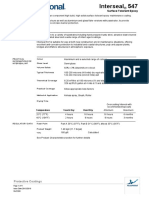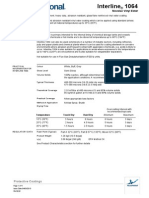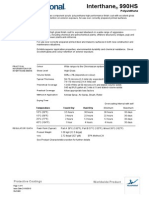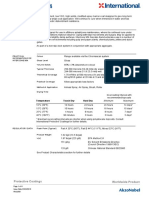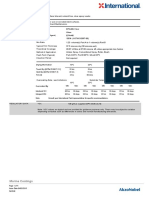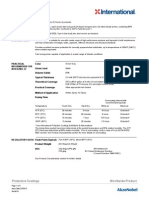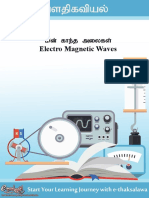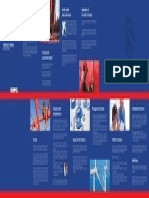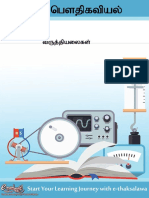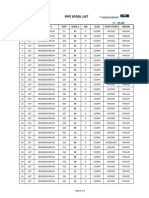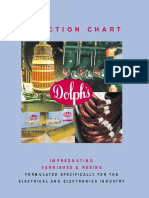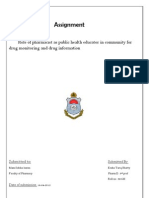Protective Coating-3
Protective Coating-3
Uploaded by
Sivaratnam NavatharanCopyright:
Available Formats
Protective Coating-3
Protective Coating-3
Uploaded by
Sivaratnam NavatharanOriginal Title
Copyright
Available Formats
Share this document
Did you find this document useful?
Is this content inappropriate?
Copyright:
Available Formats
Protective Coating-3
Protective Coating-3
Uploaded by
Sivaratnam NavatharanCopyright:
Available Formats
A two component epoxy anti-corrosive primer.
PRODUCT
DESCRIPTION
For use on properly prepared surfaces in both new construction situations and as an industrial
maintenance primer for a wide range of anti-corrosive coatings systems for use in the offshore,
petrochemical, chemical, pulp and paper and bridge industries.
The fast drying and handling properties, together with extended overcoatability, make this an
excellent primer for factory application prior to full system application on site. Intergard 291 provides
good abrasion resistance which minimises mechanical damage in transit between the factory and
site.
INTENDED USES
Buff, Grey, Red Oxide, White
Matt
53%
50-75 microns (2-3 mils) dry equivalent to
94-142 microns (3.8-5.7 mils) wet
7.10 m/litre at 75 microns d.f.t and stated volume solids
283 sq.ft/US gallon at 3 mils d.f.t and stated volume solids
Allow appropriate loss factors
Airless Spray, Air Spray, Brush, Roller
PRACTICAL
INFORMATION FOR
INTERGARD 291
Colour
Gloss Level
Volume Solids
Typical Thickness
Theoretical Coverage
Practical Coverage
Method of Application
Drying Time
Temperature Touch Dry Hard Dry Minimum Maximum
See Product Characteristics section for further details
Overcoating Interval with
recommended topcoats
10C (50F) 5 hours 24 hours 24 hours 12 months
15C (59F) 3 hours 12 hours 16 hours 12 months
25C (77F) 1 hour 4 hours 12 hours 12 months
40C (104F) 30 minutes 3 hours 8 hours 12 months
Part A
23C (73F)
Part B
23C (73F)
Mixed
23C (73F)
1.32 kg/l (11.0 lb/gal)
REGULATORY DATA Flash Point
Product Weight
VOC
See Product Characteristics section for further details
362 g/kg EU Solvent Emissions Directive
(Council Directive 1999/13/EC)
E p o x y
Intergard
291
Page 1 of 4
Epoxy
Intergard
291
All surfaces to be coated should be clean, dry and free from contamination. Prior to paint
application all surfaces should be assessed and treated in accordance with ISO 8504:2000.
Oil or grease should be removed in accordance with SSPC-SP1 solvent cleaning.
Abrasive Blast Cleaning
Abrasive blast clean to Sa2 (ISO 8501-1:2007) or SSPC-SP6. If oxidation has occurred between
blasting and application of Intergard 291, the surface should be reblasted to the specified visual
standard.
Surface defects revealed by the blast cleaning process should be ground, filled, or treated in the
appropriate manner.
Shop Primed Steel
Weld seams and damaged areas should be blast cleaned to Sa2 (ISO 8501-1:2007) or SSPC-
SP6.
If the shop primer shows extensive or widely scattered breakdown overall sweep blasting may be
necessary.
SURFACE
PREPARATION
Material is supplied in two containers as a unit. Always mix a complete unit
in the proportions supplied. Once the unit has been mixed it must be used
within the working pot life specified.
(1) Agitate Base (Part A) with a power agitator.
(2) Combine entire contents of Curing Agent (Part B) with Base
(Part A) and mix thoroughly with power agitator.
4 part(s) : 1 part(s) by volume
Suitable Typically 40-50 microns (1.6-2.0 mils) can be
achieved
Suitable Typically 40-50 microns (1.6-2.0 mils) can be
achieved
International GTA220 (or
GTA415)
International GTA822 (or GTA415)
Do not allow material to remain in hoses, gun or spray equipment.
Thoroughly flush all equipment with International GTA822. Once units of
paint have been mixed they should not be resealed and it is advised that
after prolonged stoppages work recommences with freshly mixed units.
Clean all equipment immediately after use with International GTA822. It is
good working practice to periodically flush out spray equipment during the
course of the working day. Frequency of cleaning will depend upon amount
sprayed, temperature and elapsed time, including any delays.
All surplus materials and empty containers should be disposed of in
accordance with appropriate regional regulations/legislation.
Do not thin more than allowed by local
environmental legislation
Recommended
Recommended Gun DeVilbiss MBC or JGA
Air Cap 704 or 765
Fluid Tip E
Tip Range 0.38-0.53 mm (15-21 thou)
Total output fluid pressure at spray tip not less
than 155 kg/cm (2204 p.s.i.)
APPLICATION Mixing
Mix Ratio
Working Pot Life
Airless Spray
Air Spray
(Pressure Pot)
Brush
Roller
Thinner
Cleaner
Work Stoppages
Clean Up
10C (50F) 15C (59F) 25C (77F) 40C (104F)
10 hours 8 hours 6 hours 2 hours
Page 2 of 4
Epoxy
Intergard
291
Intergard 291 is preferred for use with systems for chemical environments where zinc based
materials can be subject to attack in both acidic and alkaline conditions.
The maximum overcoating interval will be dependent upon the integrity of the exposed film. A film
of 75 microns (3 mils) dry film thickness will normally be overcoatable after 6-12 months exposure
(depending upon the corrosivity of the environment) provided it is adequately cleaned and any
areas of mechanical damage repaired.
Over-application should be avoided as thick films will not be as good a substrate for topcoat
adhesion after ageing as those at the specified thickness. When using as a blast holding primer
avoid over-application as thick films may suffer from cohesive film splitting if subsequent coats are
also over-applied.
Over-application of Intergard 291 will extend both the minimum overcoating periods and handling
times, and may be detrimental to long term overcoating properties.
When applying Intergard 291 by brush or roller, it may be necessary to apply multiple coats to
achieve the total specified system dry film thickness.
This product will not cure adequately below 5C (41F). For maximum performance ambient curing
temperatures should be above 10C (50F).
Surface temperature must always be a minimum of 3C (5F) above dew point.
In common with all epoxies Intergard 291 will chalk and discolour on exterior exposure. However,
these phenomena are not detrimental to anti-corrosive performance.
Intergard 291 is not designed for continuous water immersion.
Where a durable cosmetic finish with good gloss and colour retention is required overcoat with
recommended topcoats.
Note: VOC values are typical and are provided for guidance purpose only. These may be subject
to variation depending on factors such as differences in colour and normal manufacturing
tolerances.
PRODUCT
CHARACTERISTICS
Intergard 291 is designed for application to correctly prepared steel. However, it is also possible to
apply over approved prefabrication primers. Further details of these can be obtained from
International Protective Coatings.
The following primers are recommended for Intergard 291:
InterH2O 280
Interzinc 12 (mist coat or tie coat may be required)*
Interzinc 22 (mist coat or tie coat may be required)*
Interzinc 42
Interzinc 52
Interzinc 315
The following topcoats are recommended for Intergard 291:
Intercryl 530 InterH2O 735
Intercure 420 Intergard 740
Interfine 629HS Interplus 770
Intergard 291 Interplus 880
InterH2O 401 Interseal 670HS
Intergard 475HS Interthane 990
Alternative topcoats are also available, consult International Protective Coatings.
SYSTEMS
COMPATIBILITY
Page 3 of 4
Epoxy
Intergard
291
Rect Top
Rect
Bottom
D
et
ail
T
o
p
Further information regarding industry standards, terms and abbreviations used in this data sheet
can be found in the following documents available at www.international-pc.com:
Definitions & Abbreviations
Surface Preparation
Paint Application
Theoretical & Practical Coverage
Individual copies of these information sections are available upon request.
ADDITIONAL
INFORMATION
This product is intended for use only by professional applicators in industrial situations in
accordance with the advice given on this sheet, the Material Safety Data Sheet and the
container(s), and should not be used without reference to the Material Safety Data Sheet (MSDS)
which International Protective Coatings has provided to its customers.
All work involving the application and use of this product should be performed in compliance with all
relevant national, Health, Safety & Environmental standards and regulations.
In the event welding or flame cutting is performed on metal coated with this product, dust and
fumes will be emitted which will require the use of appropriate personal protective equipment and
adequate local exhaust ventilation.
If in doubt regarding the suitability of use of this product, consult International Protective Coatings
for further advice.
SAFETY
PRECAUTIONS
For availability of other pack sizes, contact International Protective Coatings.
PACK SIZE 20 Litre unit Intergard 291 Part A 16 litres in a 20 litre container
Intergard 291 Part B 4 litres in a 5 litre container
U.N. Shipping No. 1263 SHIPPING WEIGHT
20 Litre unit 24.6 kg (54.2 lb) Part A
4.2 kg (9.3 lb) Part B
Shelf Life 12 months minimum at 25C (77F). Subject to re-inspection
thereafter. Store in dry, shaded conditions away from sources of
heat and ignition.
STORAGE
The information in this data sheet is not intended to be exhaustive; any person using the product for any purpose other than that specifically recommended in this data sheet without first
obtaining written confirmation from us as to the suitability of the product for the intended purpose does so at their own risk. All advice given or statements made about the product
(whether in this data sheet or otherwise) is correct to the best of our knowledge but we have no control over the quality or the condition of the substrate or the many factors affecting the
use and application of the product. Therefore, unless we specifically agree in writing to do so, we do not accept any liability at all for the performance of the product or for (subject to law)
any loss or damage arising out of the use of the product. We hereby disclaim any warranties or representations, express or implied, by operation of law or otherwise, including, without
limitation, any implied warranty of merchantability or fitness for a particular purpose. All products supplied and technical advice given are subject to our Conditions of Sale. You should
request a copy of this document and review it carefully. The information contained in this data sheet is liable to modification from time to time in the light of experience and our policy of
continuous development. It is the user's responsibility to check with their local International Paint representative that this data sheet is current prior to using the product.
Issue date: 14/12/2007
Important Note
Copyright International Paint Ltd.
, International and all product names mentioned in this publication are trademarks of, or licensed to, Akzo Nobel.
www.international-pc.com
Page 4 of 4
You might also like
- 4L60E Overhaul ManualDocument185 pages4L60E Overhaul Manualanon_89043510089% (63)
- Project On FciDocument70 pagesProject On FciDhruv Tampa50% (2)
- Process Industry Practices Coatings: PIP CTSE1000 Application of External CoatingsDocument87 pagesProcess Industry Practices Coatings: PIP CTSE1000 Application of External CoatingsSivaratnam Navatharan67% (3)
- Process Industry Practices Coatings: PIP CTSE1000 Application of External CoatingsDocument87 pagesProcess Industry Practices Coatings: PIP CTSE1000 Application of External CoatingsSivaratnam Navatharan67% (3)
- Process Industry Practices Coatings: PIP CTSE1000 Application of External CoatingsDocument87 pagesProcess Industry Practices Coatings: PIP CTSE1000 Application of External CoatingsSivaratnam Navatharan67% (3)
- Process Industry Practices Coatings: PIP CTSE1000 Application of External CoatingsDocument87 pagesProcess Industry Practices Coatings: PIP CTSE1000 Application of External CoatingsSivaratnam Navatharan67% (3)
- Case Analysis 2Document4 pagesCase Analysis 2Ivy LupacNo ratings yet
- Intergard 415Document4 pagesIntergard 415Hugo GLNo ratings yet
- Chartek 8 Product Data SheetDocument4 pagesChartek 8 Product Data SheetJomer J Simpson0% (1)
- Carboguard 703 GFDocument2 pagesCarboguard 703 GFlhanx2100% (2)
- Instructions NP EX19 6bDocument3 pagesInstructions NP EX19 6bsarahNo ratings yet
- 02.telangana Standard Data Yr 2020-21 19.08.2020Document451 pages02.telangana Standard Data Yr 2020-21 19.08.2020surya100% (1)
- I, You, He, She, It, We, They: GreetingDocument20 pagesI, You, He, She, It, We, They: GreetingkrystenNo ratings yet
- Peter Schäfer - The History of The Jews in The Greco-Roman World - The Jews of Palestine From Alexander The Great To The Arab Conquest (2003, Routledge)Document263 pagesPeter Schäfer - The History of The Jews in The Greco-Roman World - The Jews of Palestine From Alexander The Great To The Arab Conquest (2003, Routledge)Irtiza Hussain100% (3)
- Intergard 269 DatasheetDocument4 pagesIntergard 269 DatasheetBalasubramanian AnanthNo ratings yet
- Intergard 251 Tech Data SheetDocument0 pagesIntergard 251 Tech Data SheetL Mahender ReddyNo ratings yet
- Intergard 475HS: Primed SurfacesDocument3 pagesIntergard 475HS: Primed SurfaceskareemNo ratings yet
- Internationa Paint MSDSDocument4 pagesInternationa Paint MSDStsoheil100% (1)
- Interseal 547 PaintDocument4 pagesInterseal 547 PaintSUBHOMOYNo ratings yet
- Interthane 990 en O-FDocument4 pagesInterthane 990 en O-Fapde06No ratings yet
- Interprime 198 PDFDocument4 pagesInterprime 198 PDFandreaju2013No ratings yet
- Vinyl Ester-Glass Flake PaintDocument4 pagesVinyl Ester-Glass Flake PaintSimbu ArasanNo ratings yet
- Interline 1012+ds+engDocument4 pagesInterline 1012+ds+engSUBHOMOYNo ratings yet
- Interthane 990 HS DatasheetDocument4 pagesInterthane 990 HS DatasheetBalasubramanian Ananth100% (1)
- Intergard 475 HS Product Datasheet PDFDocument4 pagesIntergard 475 HS Product Datasheet PDFMichael GonzalezNo ratings yet
- Interthane 990: Product DescriptionDocument4 pagesInterthane 990: Product Descriptionsorion61No ratings yet
- Interzone 954Document4 pagesInterzone 954johnson_regoNo ratings yet
- Interzone 954Document0 pagesInterzone 954hennawijayaNo ratings yet
- Interplus 1180: Protective CoatingsDocument4 pagesInterplus 1180: Protective CoatingsAnindya Aulia PratiwiNo ratings yet
- Interzone 485Document4 pagesInterzone 485Sinan A AzizNo ratings yet
- Formula 150 Primer (MILDTL-24441)Document4 pagesFormula 150 Primer (MILDTL-24441)Trịnh Minh KhoaNo ratings yet
- Interline 399Document4 pagesInterline 399pinky_y2kNo ratings yet
- TDS Interbond 201Document4 pagesTDS Interbond 201Dera Juliono SofianNo ratings yet
- Intershield 300Document4 pagesIntershield 300shameelNo ratings yet
- Interfine 629HS: Modified AcrylicDocument4 pagesInterfine 629HS: Modified AcrylicTrịnh Minh KhoaNo ratings yet
- Interbond 501Document4 pagesInterbond 501Trịnh Minh KhoaNo ratings yet
- Interbond 201: Epoxy Primer/FinishDocument4 pagesInterbond 201: Epoxy Primer/FinishBang NielNo ratings yet
- Interzone 101Document0 pagesInterzone 101hennawijayaNo ratings yet
- Interzone 1000: Glass Flake EpoxyDocument4 pagesInterzone 1000: Glass Flake EpoxyAnindya Aulia PratiwiNo ratings yet
- Interbond 808Document4 pagesInterbond 808shameelNo ratings yet
- Interprime 160Document0 pagesInterprime 160Mehman NasibovNo ratings yet
- Safeguard Universal AGDocument7 pagesSafeguard Universal AGMar PardalesNo ratings yet
- Interbond 600 PDFDocument4 pagesInterbond 600 PDFTrịnh Minh KhoaNo ratings yet
- Interseal 670 HS EN O-FDocument4 pagesInterseal 670 HS EN O-Fapde06No ratings yet
- Intergard 986Document4 pagesIntergard 986Ashta VakrNo ratings yet
- Interbond 600Document4 pagesInterbond 600Trịnh Minh KhoaNo ratings yet
- Formula 152 Topcoat (MILDTL-24441)Document4 pagesFormula 152 Topcoat (MILDTL-24441)Trịnh Minh KhoaNo ratings yet
- Carbo Guard 893 SGDocument2 pagesCarbo Guard 893 SGsuzilamatsallehNo ratings yet
- Interzinc 22: Inorganic Zinc-Rich SilicateDocument4 pagesInterzinc 22: Inorganic Zinc-Rich SilicateKristi FoxNo ratings yet
- Penguard Midcoat MIO PDFDocument6 pagesPenguard Midcoat MIO PDFEngTamerNo ratings yet
- Interbond 2340UPC Application Guidelines Rev 03 180321Document6 pagesInterbond 2340UPC Application Guidelines Rev 03 180321Kingsman 86No ratings yet
- Interzinc 75V: Zinc-Rich EpoxyDocument4 pagesInterzinc 75V: Zinc-Rich EpoxyTrịnh Minh KhoaNo ratings yet
- Interclene 5170: Controlled Depletion Polymer AntifoulingDocument4 pagesInterclene 5170: Controlled Depletion Polymer AntifoulingTrịnh Minh KhoaNo ratings yet
- Interzinc 52: Epoxy Zinc-RichDocument4 pagesInterzinc 52: Epoxy Zinc-RichKrishna VachaNo ratings yet
- Futura Classic: Technical Data Sheet Application GuideDocument7 pagesFutura Classic: Technical Data Sheet Application GuideyugandharNo ratings yet
- AG 11260 Hardtop XPL Euk GBDocument6 pagesAG 11260 Hardtop XPL Euk GBTamer GamalNo ratings yet
- Interzinc 52Document4 pagesInterzinc 52mirzaaliNo ratings yet
- Interline 984C - Technical Data SheetDocument4 pagesInterline 984C - Technical Data SheetIleanaNo ratings yet
- Interline 850Document4 pagesInterline 850shameelNo ratings yet
- Hardtop XPL AGDocument6 pagesHardtop XPL AGHung NGUYEN SYNo ratings yet
- E-Program Files-AN-ConnectManager-SSIS-TDS-PDF-Enviroline_376F_30LT_eng_usa_LTR_20240104Document4 pagesE-Program Files-AN-ConnectManager-SSIS-TDS-PDF-Enviroline_376F_30LT_eng_usa_LTR_20240104asaquin1990No ratings yet
- Penguard Topcoat: Technical Data Sheet Application GuideDocument7 pagesPenguard Topcoat: Technical Data Sheet Application GuideTamerTamerNo ratings yet
- Intershield 5150LWT: Light Weight Epoxy Non-Skid Deck CoatingDocument4 pagesIntershield 5150LWT: Light Weight Epoxy Non-Skid Deck CoatingbandarbadhonNo ratings yet
- Jotun Resist 86 Data SheetDocument7 pagesJotun Resist 86 Data SheetKunal AjgaonkarNo ratings yet
- Penguard Express ZPDocument5 pagesPenguard Express ZPMustafa Al-YasseriNo ratings yet
- Interspeed 640Document4 pagesInterspeed 640Stefano CostaNo ratings yet
- Carboguard 885 PDSDocument2 pagesCarboguard 885 PDSsyazwanjohnmazlanNo ratings yet
- Interline 994LT - fournisseurDocument4 pagesInterline 994LT - fournisseursandrineguerin2012No ratings yet
- Interseal 670 HSDocument4 pagesInterseal 670 HSSyawaluddin Fitri AwangNo ratings yet
- Residential Asphalt Roofing Manual Design and Application Methods 2014 EditionFrom EverandResidential Asphalt Roofing Manual Design and Application Methods 2014 EditionNo ratings yet
- Inside the Pill Bottle: A Comprehensive Guide to the Pharmaceutical IndustryFrom EverandInside the Pill Bottle: A Comprehensive Guide to the Pharmaceutical IndustryNo ratings yet
- அணுக்கட்டமைப்புFileDocument12 pagesஅணுக்கட்டமைப்புFileSivaratnam Navatharan100% (1)
- காசிஆனந்தன் கவிதைகள்Document97 pagesகாசிஆனந்தன் கவிதைகள்Sivaratnam NavatharanNo ratings yet
- Electro Magnetic Waves: KPD Fhe J MiyfsDocument8 pagesElectro Magnetic Waves: KPD Fhe J MiyfsSivaratnam NavatharanNo ratings yet
- Hempel Code of ConductDocument2 pagesHempel Code of ConductMashudi FikriNo ratings yet
- 19 திருசியமானிFile PDFDocument14 pages19 திருசியமானிFile PDFSivaratnam NavatharanNo ratings yet
- Ngsjpftpay : Tpuj JpaiyfsDocument16 pagesNgsjpftpay : Tpuj JpaiyfsSivaratnam NavatharanNo ratings yet
- Aramco Abrasive and Samss#Document2 pagesAramco Abrasive and Samss#Sivaratnam Navatharan100% (1)
- Coal SlagDocument4 pagesCoal SlagSivaratnam NavatharanNo ratings yet
- Welder Certification PDFDocument3 pagesWelder Certification PDFSivaratnam NavatharanNo ratings yet
- Blasting TechniquesDocument16 pagesBlasting TechniquesSivaratnam Navatharan100% (1)
- Welding PositionsDocument116 pagesWelding PositionsASAPASAPASAPNo ratings yet
- Srilanka Shre MarketDocument35 pagesSrilanka Shre MarketSivaratnam NavatharanNo ratings yet
- Srilankan Share MarketDocument35 pagesSrilankan Share MarketSivaratnam Navatharan100% (1)
- Painting Release RFIDocument2 pagesPainting Release RFISivaratnam NavatharanNo ratings yet
- Is Vigneswaran Fit To Be Chief Minister of Tamils?Document12 pagesIs Vigneswaran Fit To Be Chief Minister of Tamils?Sivaratnam NavatharanNo ratings yet
- Protective Coating Article-1Document173 pagesProtective Coating Article-1Sivaratnam Navatharan100% (1)
- Plastic Jerry CanDocument26 pagesPlastic Jerry CanSivaratnam NavatharanNo ratings yet
- The Art of StalkingDocument6 pagesThe Art of Stalkingkevinfunk2003No ratings yet
- GCED-A Guide For PolicymakersDocument9 pagesGCED-A Guide For PolicymakersThao HuynhNo ratings yet
- Info Iec60810 (ed5.0.RLV) enDocument35 pagesInfo Iec60810 (ed5.0.RLV) enBintang AntaresNo ratings yet
- H1285 JU2000E Outline Specification R0Document4 pagesH1285 JU2000E Outline Specification R0Joao CarlosNo ratings yet
- Sanitary Well CapsDocument3 pagesSanitary Well CapsNaveen KumarNo ratings yet
- 8.1 Abiotic & Biotic ComponentsDocument10 pages8.1 Abiotic & Biotic ComponentsMohamad EffendiNo ratings yet
- The European Journal of Applied Economics - Vol. 16 #2Document180 pagesThe European Journal of Applied Economics - Vol. 16 #2Aleksandar MihajlovićNo ratings yet
- Energy, Energy Transfer, and General Energy Analysis: Thermodynamics: An Engineering Approach, 6 EditionDocument10 pagesEnergy, Energy Transfer, and General Energy Analysis: Thermodynamics: An Engineering Approach, 6 EditionJeff HardyNo ratings yet
- K21YB PresentationDocument3 pagesK21YB PresentationRishabh MishraNo ratings yet
- G318 Mod2 RiskAssessmentDocument82 pagesG318 Mod2 RiskAssessmentsdfwefNo ratings yet
- Modbus Ethernet ManualDocument52 pagesModbus Ethernet ManualCarlos MercadoNo ratings yet
- How To Build A Disaster Recovery Plan: Best Practices, Templates and ToolsDocument6 pagesHow To Build A Disaster Recovery Plan: Best Practices, Templates and ToolsLevi LeonardsNo ratings yet
- Manual ObsteDocument1,237 pagesManual ObsterobingpNo ratings yet
- Dolphs Varnishs Resin ChartDocument3 pagesDolphs Varnishs Resin ChartFernando Rodriguez100% (1)
- B9 Passage PlanningDocument2 pagesB9 Passage PlanningKeane PintoNo ratings yet
- Limn Demo Circuito Flotacion PDF FreeDocument36 pagesLimn Demo Circuito Flotacion PDF FreeMuhammad ANo ratings yet
- 350 Series Broce Broom Parts Catalog 404001-404561 MANUAL BA-04Document126 pages350 Series Broce Broom Parts Catalog 404001-404561 MANUAL BA-04Eduardo SainzNo ratings yet
- Falin-Math of Finance and Investment 3 PDFDocument97 pagesFalin-Math of Finance and Investment 3 PDFAlfred alegadoNo ratings yet
- Heal Your Soul With Sound Therapy - Vibrational Healing - Sound Healing For BeginnersDocument14 pagesHeal Your Soul With Sound Therapy - Vibrational Healing - Sound Healing For BeginnersrenderthyshaftNo ratings yet
- Modul 4 Kls 10Document24 pagesModul 4 Kls 10Devi Syaeful RahmanNo ratings yet
- Soalan Science Tingkatan 1Document8 pagesSoalan Science Tingkatan 1Sabri Awang100% (1)
- Role of A Pharmacist in Health Care SystemDocument7 pagesRole of A Pharmacist in Health Care SystemAnna KhalidNo ratings yet
- P-51d Mustang Semff Combat Plane Tiled LetterDocument12 pagesP-51d Mustang Semff Combat Plane Tiled LetterPatricio AbarzaNo ratings yet















